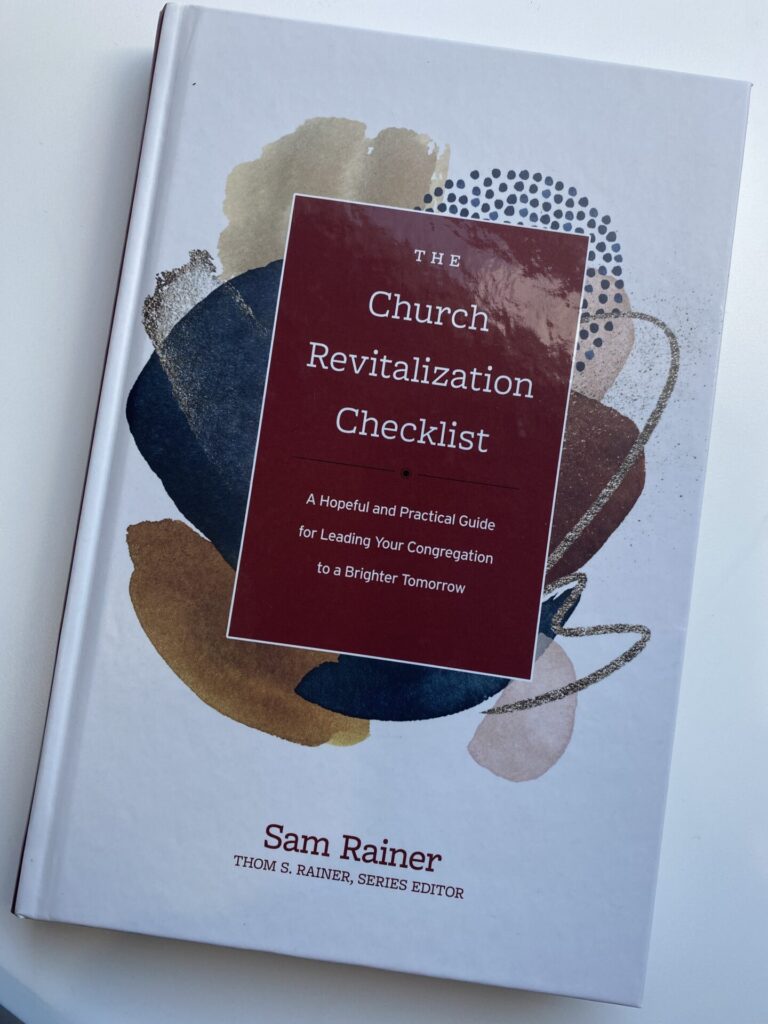Rainer, Sam. The Church Revitalization Checklist: A Hopeful and Practical Guide for Leading Your Congregation to a Brighter Tomorrow. (Tyndale Momentum, Carol Stream, Ill., 2021). 176 pages.
Review by Jeff Mingee

Pastoral ministry is challenging work. While no ministry is easy, some contexts present uniquely challenging ministry. Church Revitalization is a challenging context which requires great leadership capacity, a deep conviction of a glorious calling, and a resolve to stick to the work. In The Church Revitalization Checklist Sam Rainer provides a helpful and hopeful guide for leaders looking for direction in the work of revitalization.
Rainer serves as the Lead Pastor at West Bradenton Baptist Church in West Bradenton, FL. He co-hosts the Est. Church Podcast and is the President of Church Answers. He regularly coaches local church pastors and has led a church through the revitalization process. For full disclosure, Sam coached me while at my last church. Our church reached out to Church Answers and I found Sam to be greatly helpful. Both the content and the tone of his coaching came through in the book. I looked to Sam as a trusted voice in the field of church leadership before I read The Church Revitalization Checklist. Even more so having read the book.
In The Church Revitalization Checklist, Sam Rainer writes to encourage and help. He lifts the reader’s weary eyes from the daily grind of ministry in a church that needs revitalization and points to Christ and to a greater future for their church. Rainer explains, “As you persevere, I encourage you to bend toward hope” (4). In the introduction alone, Rainer repeatedly uplifts the reader, “your congregation is worth revitalizing” and “if God can save any person, he can save any church.” But this is not mere cheerleading or shallow encouragement. Rainer intends to coach the reader. He asks piercing questions and provides practical exercises which will reveal a church’s need for revitalization and some key factors they will face in the process. Finally, Rainer provides clear direction as pastors plan a path forward.
In chapter one, Rainer points out that many churches hit the pause button when they need to hit the reset button. They’re stuck in the past and need a leader who will have the courage to lead them into tomorrow. Rainer writes, “This chapter is less about getting an exact prediction right and more about getting the posture of leadership right” (23). He reveals cultural trends which have led to the need for revitalization including a lack of evangelism, a widening generation gap in the church, a healthy expectation for diversity, declining attendance trends, and others.
In chapter two Rainer provides an overview of why a checklist is needed for revitalization. He explains, “More information is not the answer. Neither is more skill or training. The solution is a simple system of accountability: a checklist.” (44). Drawing from his own use of checklists Rainer highlights three benefits: illustrating visual progress, providing constant accountability, and fostering a consistent focus. Rainer recognizes that his checklist is not exhaustive. He explains it is, “collaborative, not formulaic […] flexible, not systematized […] practical, not theological” (46-48).
In chapter three Rainer lays the foundation of priorities in the work of revitalization. He warns “Churches decline for two main reasons—both having to do with a shift in priorities. First, they lose passion for the Great Commission and the Great Commandment. Second, as a result, they no longer give God glory” (58). Rainer hints at more detailed coaching he will provide later as he provides some practical but general direction such as “focus more on ‘going out’ than ‘growing big’” and “embrace children, don’t just tolerate them.” Readers develop a sense of hope for their church and an understanding of what it will take to get there. Rainer concludes, “Two movements—outward and upward—should determine every priority in the church. […] How can you discern what is most urgent? Whatever moves your church outward and upward will also propel you onward” (70).
In chapter four Rainer discusses the pace at which a pastor can tackle changes in revitalization. He writes, “Leading a church revitalization with a hopeful tone is a delicate balance between patience and urgency. You must have the patience to walk with people and the urgency to encourage them to pick up the pace” (72). Rainer provides the first of many practical tools here, as he introduces The Pace Acceptance Matrix. After making a compelling case for gradual change he provides some steps for the pastor including, make prayer the top priority, lead by example with evangelism, show love when tested, and be prophetic without blaming others.
In chapter five Rainer writes about perspective or expectations. He warns against dreaming of another location, another community, and another time. Revitalizing pastors know the temptation of dreaming up a call to another work. Rainer writes, “Having the right perspective means realizing that, until he moves you, God has you right where he wants you. […] Dream about what God can do with you and the people of your church, right here and right now” (96).
In chapter six Rainer turns the attention to the people of the church. He asks, “Are you willing to love your people where they are now?” (103). He provides more diagnostic questions and another tool which will uncover the church’s capacity to change. One especially encouraging section in this chapter is a review of the ministry of missionary William Carey. Revitalizing pastors are encouraged by Carey’s example of faithfulness.
In chapter seven Rainer points briefly to the physical building in which the church gathers. Ironically, or intentionally, this chapter is more about mission than location. Rainer points out, “the church campus is not the most important discipleship tool, but it is often the most prominent” (118). Again, he provides a diagnostic exercise to help readers determine what role their current facility may play in their revitalizing work.
Rainer opens chapter eight, “This next part of the checklist helps to answer an important question: What can you do to shift your church to an outward focus? Without a rekindling of evangelism and outreach, a struggling church will not be revitalized” (139). In his coaching style, Rainer is both pastoral and prophetic. He is not afraid to make observations which some pastors would rather avoid. For example, he challenges the pastor to lead by example in evangelism and writes, “The only way your church has no one inviting others is if you are not inviting others” (141). He then calls them to action, “As a leader, free up one to three hours a week on your calendar with the explicit purpose of inviting guests and sharing your faith” (142)
In chapter nine Rainer helps the reader develop a pathway forward. He adapts a phrase from Jim Collins’ Good to Great and encourages pastors to create an “MHAG” or Mid-Holy-Audacious-Goal. Rainer provides compelling information and clear explanation on how to create a healthy goal for a revitalizing church. Finally, in chapter ten, Rainer provides a fictional narrative of a church going through the Church Revitalization Checklist.
Some readers may wish for a more theological approach to church revitalization. They are looking for more exegesis where Rainer provides application. Again, Rainer gave the disclaimer that this checklist is “practical, not theological” (48). He correctly observes that “right theology wrongly applied in church revitalization can do more harm than good” (49). However, the church is inherently theological. It is, many argue, built on the Word. And Rainer provides little, if any, content on the role of preaching in church revitalization. He also overlooks those biblical passages such as Hebrews 13 which warn church leaders of the account they will one day give. Readers are left to discern whether this checklist will serve them well when they give that account. I, for one, believe it will serve them well in many ways.
Readers will find themselves underlining nearly every page of The Church Revitalization Checklist and nodding in agreement while leaning back in reflection. Each chapter includes helpful tools and diagnostic exercises church leadership teams can complete together. Rainer writes as he coaches, with a helpful eye to application and a tender tone. Readers are given hope. They are pointed to a better future. They are not berated or made to feel unappreciated because they are in the work of revitalization. No, Rainer writes with appreciation for the revitalizing pastor. In fact, he shows a great deal of admiration to local church pastors just like his wife’s grandfather, Ambrose Gilbert Sapp. Yes, may his tribe increase indeed as Rainer writes in the dedication. And may revitalizing pastors be encouraged by his example and by Rainer’s helpful words on this glorious calling.
